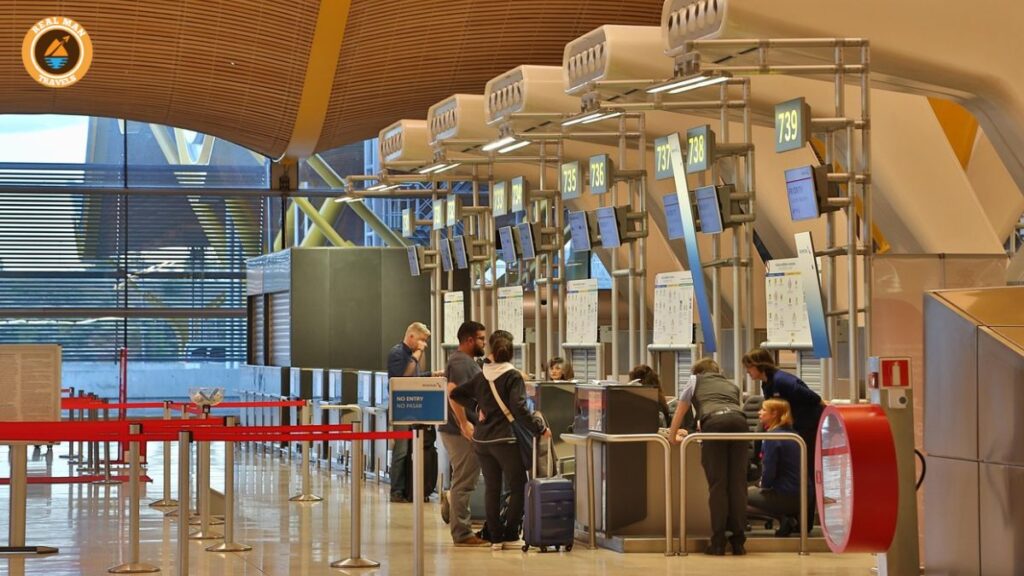Intro: How to Check Travel Warnings Online
How to Check Travel Warnings Online: The world is a dynamic place, and conditions in any given country can change rapidly. Understanding how to check travel advisories online is a necessary skill for anyone planning a journey abroad in 2025. This detailed guide will offer you the knowledge and tools to browse global travel alerts, ensuring your journey is as protected as it is remarkable.

This guide will walk you through the primary sources for official travel advisories, discuss the different levels of warnings, and show you how to interpret the details you find. We will cover the step-by-step process for checking information from essential federal government agencies, explore supplemental resources, and provide valuable suggestions on what to do if a warning is issued for your destination. By the end, you will be geared up to make informed decisions, transforming prospective unpredictability into positive and accountable travel preparation.
Comprehending the Landscape of Travel Advisories
Before diving into the “how,” it’s crucial to comprehend the “what” and “why” behind travel warnings, a travel caution, or a travel advisory, which is a prominent notice issued by a government or international body that provides details about the safety and security conditions in a particular nation or area, these advisories are not intended to discourage travel entirely but to equip citizens with the necessary details to assess dangers and take suitable safety measures.
These alerts are compiled using a wide range of information from embassies, consulates, intelligence firms, and local authorities. They consider various elements, consisting of:
- Political Instability: Civil unrest, demonstrations, coups, or unforeseeable federal government actions.
- Crime: High rates of petty or violent crime targeting immigrants.
- Terrorism: Credible risks or recent activity from terrorist companies.
- Health Risks: Outbreaks of infectious illness, pandemics, or inadequate medical facilities.
- Environmental Dangers: Natural catastrophes like cyclones, earthquakes, tsunamis, or volcanic eruptions.
- Specific Safety Concerns: Issues associated with local laws, infrastructure, or threats targeting specific demographic groups.
By understanding the basis of these warnings, you can better appreciate their significance and utilise them as a tool for proactive travel planning.
Primary Sources: Your Go-To Government Websites
The most authoritative and trusted sources for travel warnings are your own federal government’s official channels. These agencies have a beneficial interest in the security of their residents abroad and have the resources to gather and validate information globally. Here are the primary sources for several crucial countries.
For U.S. Citizens: The U.S. Department of State
The U.S. Department of State’s Bureau of Consular Affairs is the definitive resource for American tourists. Their system is uncomplicated and colour-coded, making it easy to comprehend the danger level at a glance.
How to Check Travel Advisories on Travel.State.Gov:
- Browse to the Website: Open your web browser and go to travel.state.gov.
- Discover the Travel Advisories Section: The homepage plainly features a search bar where you can “Find Travel Information for a Country.”
- Enter Your Destination: Type the name of the nation you plan to visit and choose it from the dropdown list.
- Evaluate the Advisory Level: The nation’s page will immediately show the current Travel Advisory Level. The U.S. utilises a four-tier system:
- Level 1: Exercise Normal Precautions (Blue): This is the lowest advisory level for security and security threats. Conditions are similar to what you might experience in the United States.
- Level 2: Exercise Increased Caution (Yellow): Be mindful of increased dangers to security. The nation may have experienced increased crime rates or a heightened capacity for civil unrest.
- Level 3: Reconsider Travel (Orange): Avoid travel due to severe dangers to security. The U.S. federal government may have limited ability to assist in these areas.
- Level 4: Do Not Travel (Red): This is the highest advisory level, indicating a higher likelihood of significant risks. During an emergency, the U.S. federal government may have limited capability to assist.
- Read the Details: Below, you’ll find a detailed summary explaining why the advisory was released. It will break down risks by specific areas within the nation and provide actionable advice for tourists.
For Canadian Citizens: Global Affairs Canada
The Government of Canada supplies robust and comprehensive travel recommendations and advisories for its people. Their system is likewise structured to assist Canadians in making travel choices.

How to Check Travel Advisories on Travel.gc.ca:
- Go to the Official Site: Go to travel.gc.ca.
- Select Your Destination: Use the search bar on the homepage to enter the name of your location’s nation.
- Analyse the Risk Level: Canada utilises a four-level system, each with a clear recommendation:
4.
- Exercise normal security preventative measures: Similar to the U.S. Level 1.
- Exercise a high degree of caution: Indicates identifiable safety and security concerns.
- Avoid non-essential travel: Particular safety and security issues might put you at risk. You ought to reconsider your need to travel.
- Avoid all travel: There is a severe threat to your individual safety and security.
Examine the Tabs: The nation page is organised into tabs such as “Risk,” “Safety and security,” “Entry/exit requirements,” and “Health.” The “Risk” tab provides general advisory information, while the “Safety and security” tab offers extensive details on crime, terrorism, and political instability.
For UK Citizens: The Foreign, Commonwealth & Development Office (FCDO).
British nationals should seek advice from the FCDO for the latest travel advice. The guidance is practical and frequently updated based on information from UK embassies and consulates.
How to Check Travel Advice on GOV.UK:.
- Go to the FCDO Page: Navigate to the Foreign Travel Advice area on gov.uk/gov.uk/foreign-travel-advice.
- Search for Your Country: A search bar and an A-Z list of countries are readily available. Select your location.
- Review the Summary: The nation page begins with a summary of the existing situation and any FCDO recommendations regarding travel. The FCDO typically advises against “all travel” or “all however necessary travel” to particular regions or the entire nation.
- Check Out Detailed Sections: The recommendations are broken down into sections like “Safety and security,” “Terrorism,” “Local laws and customs,” and “Health.” These provide extensive information that surpasses the initial summary.
For Australian Citizens: Smartraveller.
The Australian Government’s Smartraveller site is the official source of travel advice for its residents. It is handled by the Department of Foreign Affairs and Trade (DFAT).
How to Check Travel Advisories on Smartraveller.gov.au:.
- Access the Website: Visit smartraveller.gov.au.
- Find Your Destination: Use the search function to search for the country you plan to check out.
- Understand the Advice Level: Smartraveller utilises a four-level system.
- Level 1: Exercise typical safety precautions.
- Level 2: Exercise a high degree of caution.
- Level 3: Reconsider your requirement to take a trip.
- Level 4: Do not travel.
5. Check Out the Full Advice: The advisory page provides a summary at the top, followed by in-depth sections covering security, health, regional laws, and more. It’s essential to review the entire page to understand the specific risks mentioned.
A Deeper Dive: How to Interpret Travel Warnings.
Finding a travel warning is only the very first step. The real skill depends on interpreting the details correctly to make a sound judgment about your travel plans.
Look Beyond the Level.
A “Level 2: Exercise Increased Caution” advisory for one nation might be issued due to pickpocketing in traveller locations, while the same level for another country might be due to sporadic political demonstrations. The advisory will define the nature of the hazard, which allows you to evaluate your personal risk tolerance.
Look For Regional Specificity.
Numerous advisories do not apply to the entire nation. Pay close attention to maps and regional descriptions within the advisory.
Consider the Date of the current Update.
Advisories are vibrant. Try to find the “Last Updated” date on the advisory page. An alert that was last updated a year ago may not accurately reflect the current reality on the ground. On the other hand, a recently upgraded caution indicates an active and developing situation that necessitates closer attention. Establish alerts if possible, so you are informed of any changes before and throughout your trip.
The Smart Traveller Program: Your Safety Net Abroad.
One of the most crucial actions you can take after reviewing travel advisories is to enrol in your government’s registration program for people abroad.
- For U.S. Citizens: The Smart Traveller Enrollment Program (STEP) is a complimentary service that permits you to register your trip with the nearest U.S. Embassy or Consulate. In an emergency — whether it’s a natural disaster, civil unrest, or a household emergency — the embassy can contact you, offer information, and provide assistance from back home.
- For Canadian Citizens: The Registration of Canadians Abroad service functions likewise, enabling the government to reach you in case of an emergency.
- For UK and Australian Citizens: Both governments provide similar registration services through their respective foreign affairs websites.

Enrolling takes just a few minutes and is one of the best safety measures you can take. It offers a direct line of interaction between you and your nation’s official representatives on the ground.
Beyond Government Advisories: Supplemental Resources for a 360-Degree View.
While federal government advisories must be your primary source, supplementing them with other resources can provide a more nuanced and on-the-ground perspective.
Expat Forums and Social Media Groups.
People who live in your country often have the most present insights into the daily truths of safety and security. You can ask specific questions about the communities you plan to visit or the current beliefs in the nation. Always treat this info with a degree of suspicion and cross-reference it with official sources.
International News Outlets.
Follow trustworthy global news companies like Reuters, the Associated Press (AP), BBC World News, and Agence France-Presse (AFP). These outlets have reporters around the globe and frequently report on developing situations before they escalate to the level of a main travel caution. Researching news about your destination in the weeks leading up to your trip can provide you with a better understanding of the local political and social environment.
Travel Insurance Providers and Security Firms.
Numerous primary travel insurance business maintain their own risk assessment departments and publish travel safety information. Many policies ended up being advisory if you travel to a place, rather than a “Do Not Travel” or “Avoid All Travel” directive.
If a Travel Warning Is Issued for Your Destination, What Should You Do?
Discovering a travel caution for a trip you’ve already scheduled can be demanding. Here’s a calm, systematic approach to handling the scenario.
- Read Carefully. Take a deep breath and read the whole advisory. Is it for a particular area or the entire country you will not be visiting?
- Examine Your Personal Risk. Consider your travel experience, convenience, and health level. A seasoned backpacker might be comfortable browsing a country with a “Level 2” warning for criminal offences, whereas a Family with kids might choose to hold off on the journey. There is no one-size-fits-all answer.
- Contact Your Airline and Hotel. Check their modification and cancellation policies. In cases of significant events, such as natural disasters or political coups, many airline companies and hotels offer waivers, allowing you to change your dates or receive a refund.
- Evaluate Your Travel Insurance Policy. This is critical. Call your insurance company and ask them straight how the new advisory impacts your protection. Understand the specific clauses associated with federal government cautions. Some policies may permit you to “cancel for any reason” (CFAR), which provides the most flexibility.
If you decide to proceed with your trip to a nation with a heightened advisory, produce a solid contingency strategy. Be aware of the location and contact information for your country’s embassy or consulate. Prevent locations mentioned as high-risk in the advisory.
Conclusion: Travel with Confidence and Awareness.
Examining travel cautions online is no longer an optional step for the conscientious traveller; it is an essential part of trip planning in 2025. By leveraging the official resources provided by your federal government, you can gain a clear and authoritative understanding of the conditions at your destination. Supplementing this with details from on-the-ground sources and news outlets provides you with a well-rounded view, allowing you to move past fear and toward informed awareness.

Remember that the goal of these advisories is not to deter you from exploring the world, but to empower you to do so securely and intelligently. By following the steps described in this guide — from enrolling in and inspecting leading websites in traveller programs to translating the subtleties of each alert — you transform yourself from a tourist into a ready global citizen. Safe journeys.
Often Asked Questions (FAQ).
Q1: How typically are main travel cautions upgraded?
A1: Official federal government travel advisories are upgraded whenever there is a substantial modification in the safety or security situation in a country. For some steady countries, the advisory may not change for months or even years.
Q2: Will my travel insurance stand if I travel against a federal government advisory?
Most standard travel insurance coverage policies will not cover you if you travel to a nation or area where your government has issued a “Do Not Travel” or “Avoid All Travel” advisory. For lower-level cautions, such as “Exercise Increased Caution,” you are generally still covered, but you may be expected to take affordable preventive measures.
Q3: What’s the distinction between a travel warning and a travel alert?
The U.S. Department of State traditionally utilises “Travel Alerts” for short-term events (e.g., demonstrations, a health outbreak, or evidence of an elevated risk of terrorist attacks) and “Travel Warnings” for more prolonged, long-lasting conditions that make a country hazardous or unstable. The current U.S. system has consolidated this into a single “Travel Advisory” for each nation, utilising the four-level system to indicate the threat level.
Q4: Can I rely solely on the federal government’s travel advisory site?
A4: Your federal government’s official advisory website should be your primary and most trusted source of information. Reading worldwide news, checking expat forums for on-the-ground perspectives, and examining health organisation reports (such as those from the WHO or CDC) can provide additional context that helps you make a more informed choice.
Q5: What should I do if a travel caution is released while I am currently in the country?
A5: If a warning is issued or upgraded while you are currently at your location, the first action is to review the advisory carefully to understand the specific threats. Wait for assistance from your embassy or consulate if you are registered in a program like STEP. They will send out information with directions. In basic, prevent any areas of discontent, restrict your non-essential motions, and ensure you have an interaction strategy with your Family back Home. If the circumstances are extreme and an evacuation is suggested, follow all official guidelines to leave the country safely.
A travel caution, also known as a trip advisory, is an official notice released by a government or international body that provides details about the safety and security conditions in a specific country or region. The FCDO often encourages versus “all travel” or “all but vital travel” to particular areas or the entire country. Many policies ended up being void if you travel to a place against a “Do Not Travel” or “Avoid All Travel” directive.
A lot of basic travel insurance policies will not cover you if you travel to a country or area where your federal government has provided a “Do Not Travel” or “Avoid All Travel” advisory. The U.S. Department of State traditionally utilises “Travel Alerts” for short-term events (e.g., presentations, a health breakout, or an elevated danger of terrorist attacks) and “Travel Warnings” for more prolonged, long-lasting conditions that make a nation dangerous or unstable.


2 thoughts on “How to Check Travel Warnings Online: A Step-by-Step Guide for 2025”